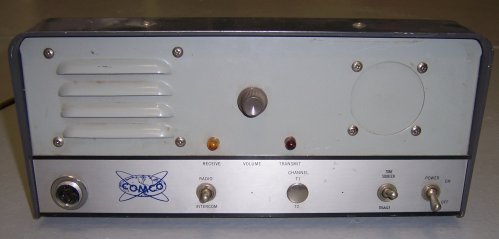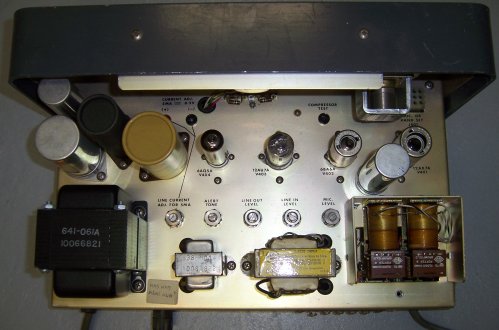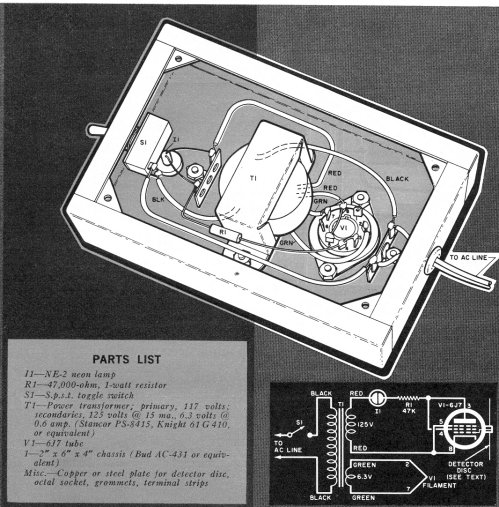- Which movie theater did you go to on your first date? Whether or not that theater still exists, this site may have a photo of it, along with other interesting historical data. The first theater I took Carol to is this one. It’s still there, and still awesome. (Thanks to Ernie Marek for the link.)
- Five years later, I proposed to Carol while we watched the sun set from a bluff overlooking the Mississippi River. There are other ways of doing it. I forgot to bring a flashlight up the side of that bluff, and we had to pick our way down in near-darkness. My nerdiness has gaps. (Thanks to Bruce Baker for the link.)
- The Softpro retail bookstore at the Denver Tech Center is closing its doors at the end of March. Even though it’s 70+ miles away, I’ve dropped a fair bit of change there. Bummer.
- Back in the 50s, the Russians were producing an extremely interesting line of low-voltage tubes. I’m still trying to get my head around how they work internally, but hey, “Gammatron” is a wonderful name for a line of tubes–or anything else. (Thanks to Jim Strickland for the link.)
- The war on “moist” (see yesterday’s entry) prompted Bruce Baker to remind us of Moist von Lipwig, a Discworld character whose distinguishing characteristic is having no distinguishing characteristics. See Going Postal and Making Money .
- People are still selling tumbleweeds on eBay. I can’t figure it. If the world has an abundance of anything, it’s tumbleweeds. Unless maybe you live in New York City and want some Western ambience without ever actually going there.
- When I was in college, a girl told me: “The trouble with you, Jeff, is that you’re too damned happy!” Guilty. And this research sounds like BS to me, in part because low expectations are not the same as pessimism. And also in part because most pessimists I’ve spent time with seem pretty unhappy. But what do I know? I’m a pessimism denier.
- The Atlantic reports research suggesting that the Neanderthals went extinct because they ran out of woolly mammoths and couldn’t get their substantial (and hard) heads around hunting bunnies. I’m still convinced that they wiped themselves out for lack of dogs. (Thanks to Bruce Baker for the link.)
- Humanoid robots could make good firefighters, and the Navy is working on it. I’ll believe it when I see it, of course, but I keep thinking that a humanoid robot who can fight fires can do a lot of other interesting things. (Thanks to Bp. Sam’l Bassett for the link.)
- God sometimes teaches stupid people harsh lessons–and sometimes they’re so funny they hurt. (Thanks to Pete Albrecht for the link.)
tubes
Odd Lots
The Comco Whatchamacallit

I hung yet more Elfa shelves downstairs the other day, on the only remaining blank wall in my peculiar workshop. I’m trying to get stuff off the floor and into some semblance of order. A number of tube-era radios went up on the shelves almost immediately, including a Heath HW-22A and a pair of Ameco TX-62s, one of which is a parts unit. So did something else: the tube-era thingie shown above, which has been following me around for almost twenty years. I bought it at a hamfest in the early ’90s for a dollar. The old guy who sold it to me didn’t know what it was. I bought it for the sake of the transformers inside, which were worth that much even in 1993. It turns on, lights up, and hums softly. I still don’t know what it’s supposed to do.

It’s made by Comco Communications Company, of Coral Gables, Florida. Its model number is 642-RCU. From the “RCU” I’d guess a radio control unit, or remote control unit. It has no RF parts inside. There’s an audio power amp with a 6AQ5A driving a speaker behind the grille. The front panel has a 4-pin PTT mic jack, a momentary action toggle switch marked “RADIO” above and “INTERCOM” below, with “RADIO” the default position. A hole marked “CHANNEL” with “T1” above and “T2” below is plugged. A conventional toggle switch is marked “TONE SQUELCH” above and “DISABLE” below, and beside that, an On/Off toggle switch marked “POWER”. At the center of the panel is a rheostat marked “VOLUME,” and two grain-of-wheat lamps, the orange one labeled “RECEIVE” and the red one “TRANSMIT.” A round hole the size of a panel meter is plugged. On the back panel is a fuse holder, a 5-terminal strip for spade connectors marked “PHONE LINES” and and empty rectangular knockout marked “EXT. CONTROL” from which a cut-off 4-conductor cable protrudes. That might have been a hack; the cut-off cable goes directly to the mic connector.

There are two pin jacks on the chassis (see above, just past the tan electrolytic) that say, “CURRENT ADJ. 5MA == 0.5V”. I’m guessing that the meter was dropped from the product to reduce its cost, and the pin jacks provided for service techs. To their right and a little way over is another pin jack labeled “COMPRESSOR TEST.” No idea on that one.
The tube complement is: 12AX7, 6BA6, 12AU7, 6AQ5A.
I suppose it might be some kind of phone patch, though it doesn’t look like any phone patch I’ve ever seen. The “RADIO / INTERCOM” switch throws me a little, since there’s no external connector for intercom lines. I haven’t traced the tangles under the chassis to any extent yet, so if I don’t know precisely what it does, it’s partly my own fault.
And I have other things to do. Even my voracious curiosity has its limits. If you’ve ever seen one of these or want to hazard a guess, please do!
A One-Tube Electroscope
I found the circuit below by accident, while flipping through my library of Popular Electronics looking for something else. It was published in the October 1961 issue, and caught my interest because a friend of mine built it back in 1964. It was a cool thing to watch in action. It’s an electroscope that detects static charge by using the grid in a vacuum tube to control conduction. Bring an object with a static charge on it within a couple of feet of the detector disk, and the NE-2 neon bulb will light or dim, its brightness proportional to the strength and polarity of the charge. Positive charges make the bulb glow more brightly. Negative charges will dim it, or even darken it completely if the charge is strong enough to force the tube into cutoff.

(The full article can be found here–2.6 MB PDF.) The detector is a metal disk five or six inches in diameter. It can be any conductive metal. When Art built his he used sheet aluminum and it worked just fine. The center hole is sized to press-fit on the grid cap of a 6J7, which is connected to the tube’s control grid. The 6J7 works well here because it’s a metal tube, and is inherently shielded by its metal shell. (The article doesn’t call it out, but I think pin 1, connected to the shell, should be grounded to the chassis.) A 6K7 or 6S7 will substitute pin-for-pin, and I think any metal tube with the control grid brought out to a cap will work if you get the pin connections right for the tube type. NOS tubes of this sort can be had for $5-$6 from places like Antique Electronic Supply. I don’t know how well the GT (glass) versions of the tube will work, since they lack the total shielding of the “standard” 6J7’s metal shell.
The power transformer called out was common and cheap back in the day, but you’d be hard-pressed to find one now. The usual dodge is to use two 6.3V filament transformers, and connect them back-to-back. (These used to be sold at Radio Shack. I’m not sure if they are anymore.) You can light the filament from the joined 6.3V secondaries, and take isolated 120VAC from the primary of the second transformer. The 6J7’s heater current is 300 ma. Any filament transformer that can source that much current will do.
I find it interesting that raw AC is applied to the plate of the tube without rectification. The current is in fact rectified by the tube (tubes conduct in only one direction) with rectifier current controlled by the 6J7’s first grid. My first thought was that it works like a thyratron, but there’s no latching effect. Current through the tube is controlled by the charge on the grid, and then in a linear way.
It would be interesting to figure out a circuit that would indicate with a sensitive meter rather than a neon bulb, and if I build it I may try a few things. The only cautions I offer here relate to the voltage: 120V, even isolated from the wall, is dangerous. Don’t work on the circuit with power applied. To be safe, yank the plug out of the wall before you open the box or flip the chassis over. There’s no voltage on the detector plate, so that can be touched even while the device is on.
All that said, it’s a great entry-level demonstration of how vacuum tubes work.
Odd Lots
- Antique Electronic Supply in Tempe, Arizona, has created a new DBA for their tube audio amplifier business: Amplified Parts. The tube stuff still predominates but it’s hardly “antique” and has definitely gone upscale. They rate their power tubes like fine wine: “This Russian tube [6L6GC] has tight lows, straightforward body, and smooth highs. In overdrive, it offers a tight and frosted crunchy bite.”
- My Taos Toolbox 2011 colleague Alan Smale just won the Sidewise Award for Alternate History at the 2011 Worldcon in Reno. We workshopped an expansion of the winning story, “A Clash of Eagles” and it was terrific. I’m guessing this will make it perhaps a little easier to sell the novel-length work. Bravo, Alan!
- Even though HP announced yesterday that they were killing their cloud-centered TouchPad tablet, Carol and I saw an expensive commercial for the device on The Weather Channel this morning. Cloud? Did you guys say “cloud”? (No wonder they got the ad…)
- If you haven’t seen it yet, definitely take a look at Stellarium, a free planetarium program available for Windows, Mac, and Linux. It’s one of the best I’ve ever tried, more polished (if not as deep) as the venerable Cartes du Ciel, which is remarkable in part by being a Lazarus app.
- David Stafford sends word that an elaborate steampunk loft apartment has gone up for sale in Manhattan. The price? A “mere” $1,750,000.
- This is killer cool as binoculars go, but would they capture anything at night? (Somehow I doubt it.)
- Bill Higgins writes to tell us that Catholic University has placed a scan of the 1964 Treasure Chest comics series “Pettigrew for President” online, for free download. I blogged about this years ago, but the comic was not available for download then.
- Nick Kim does Cowboys and Heavy Metals. (Thanks to Pete Albrecht for the link.)
- Fellow carnivore Jim Tubman and I share an appreciation for The Periodic Table of Meat. Most of it, anyway. (No thanks on Meat 75. Oh, and 95.)
- Back from meat to metals again: Given that it’s the cornerstone material required to build the Hilbert Drive as used in many of my SF yarns, I was a little surprised that ytterbium is so cheap.
- Did you ever wonder about the physics of coffee rings? Wonder no more.
- From the Please-Give-Those-Guys-Something-To-Do Department: New taxpayer-funded NASA research tells us that unless we take prompt and serious action against global warming, aliens may invade and wipe us out. UPDATE: This turns out not to be entirely true: The chap who co-wrote the paper works for NASA but he did it on his own time and there was no public funding involved. The Guardian has corrected the piece.










